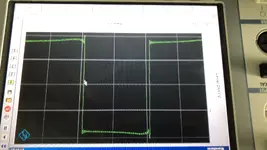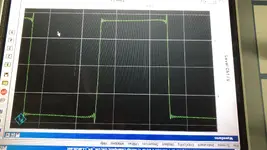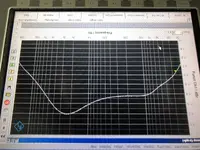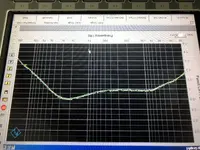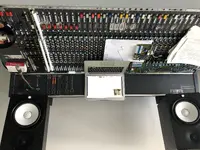[MENTION=201181]michael1991[/MENTION] thank you SO much for taking the time to dig up that information. I really appreciate it!
The reason I’m asking is because I scored a couple meter modules on eBay, one of them being a “MONITOR” module, the other, which appears to be an identical configured module is labeled “SERVICE”. They are both “tested...working”:

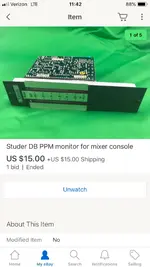
That’s right...I got the first one for $3.25USD and the second for $15.00USD. The second one was originally listed with a starting price of $5.00USD, but I think the seller bumped it up after the first one went for so cheap. That’s really cheap. I mostly see Studer 70mm meter modules selling for $100-200USD. The shipping was $15.00USD each, but the seller agreed to combine the shipping. The “SERVICE” module I’ll just keep as spares, but I’d like to use the “MONITOR” module on the control room buss.
I cleaned up one of the group modules. It’s hard to tell since overall the console is in pretty good shape, but it did shine up a bit...the one with the orange fader knob is the one I cleaned up:
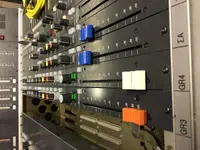
Another little update if you will has to do with some A/B listening tests I was doing between the transformer outs and non-transformer outs. I’ve just been using headphones for function testing, but I dragged my studio monitors out to the shop the other night...hooked them up as well as my MacBook and MOTU 8M interface so I could reproduce different material from a good quality source and also simultaneously track material output from both the opamp-based direct outputs on the mono input modules and from the transformer outputs on a Master module.
In the headphones I thought I was hearing a distinct difference between the two; that the transformer coupled outs sounded “better” (wider soundstage, better hi-mid clarity, maybe warmer/more present LF?). But...with the monitors hooked up, both outputs sound f***ing *awesome* to my ears. Like, I was shocked by what I was hearing compared to everything else I’ve had those monitors hooked up to...big...wide...huge...awesome...so that means either it’s really good (the Studer), or I’ve just not had the monitors hooked up to anything decent all these years. So, both output types sound awesome. I was exploring this to see if I was going to find some way to convert the non-transformer direct outs to transformer, but I don’t think so...like, I can still hear some subtle difference, like the bottom end has maybe a bit more presence with the transformer outputs, and the soundstage seems a bit wider or deeper with the transformer outputs, but I suspect that is more likely due to the transformer outs (in this case) being from a stereo VCA module vs the opamp-only output being from a pair of mono VCA modules...like there might be better stereo imaging from the stereo module. And actually that could effect the perceived LF response if there are any minor phase issues between the two mono modules vs the stereo master module.
But I just listened to different styles of familiar music at different levels for, like, two hours. I’ve been so busy for so many years it seems like it’s been a long time since I just sat down and listened to music. My monitors have never sounded so good. It’s remarkable. And what else was remarkable was how easy it was to hear elements I would consider as “issues” with even the professional mixes I was listening to. Not all of them, but a few of them. The good bad and ugly were all out there to be heard. Again, both output amps sounded great. I was A/B-ing the source throughout my listening session. I wouldn’t consider the transformer outs really “better” at this point, just a little different flavor...and maybe better stereo image, but, again, I think that may be related to one being a stereo module and the other being two mono modules.
The sales brochure for the 928 refers to all inputs and all outputs equipped with Studer transformers. I have confirmed all the inputs can be configured with transformers...the mic inputs are standard with transformers, and there are lands on all the mono and stereo input module PCBs for input transformers for the line inputs. But there is no such accommodation for output transformers except for those that are standard on the group and master modules. And physically I don’t see a way to incorporate them on the mono modules anyway...there just isn’t room. And I tipped the frame up and removed the bottom panels so I could see the motherboard and there’s no accommodation for them there, not really any room to incorporate them there. Same story on the jack PCBs. There’s probably room behind the jack PCBs, but here again as I’m taking a look, this thing is a piece of manufacturing/engineering artwork...there’s no way I could match the quality, at least not without a great deal of effort and some significant expense, were I to try and modify the direct outs with transformers, at least not the Studer circuit, which is what I’d want to do. I’m going to chalk the language in the brochure up to over-zealous marketing folks, or that it refers to trafos on the summing outputs only, and assume transformers on the direct outs never were. And the direct outs sound comparable to the transformer outs anyway to my ears using the monitors and with some varied listening. I think this is another “leave it alone”. I can’t wait until I get to the point I can mix on this thing.
 have you checked the production dates of your modules? (printed somewhere on the pcbs)
have you checked the production dates of your modules? (printed somewhere on the pcbs) have you checked the production dates of your modules? (printed somewhere on the pcbs)
have you checked the production dates of your modules? (printed somewhere on the pcbs) have you checked the production dates of your modules? (printed somewhere on the pcbs)
have you checked the production dates of your modules? (printed somewhere on the pcbs)

